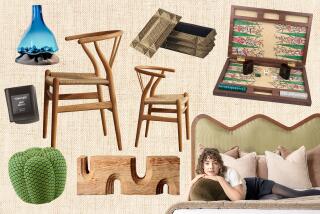Paul Tuttle, 84; Designer’s Furniture Exhibited as Art
Paul Tuttle, an internationally recognized designer best known for his modern, elegant furniture, died in his Santa Barbara home on Aug. 2 after a long illness. He was 84.
Tuttle’s body of work included custom and manufactured furniture, as well as architectural and interior projects in Santa Barbara, his home since 1956.
One of his signature pieces was the 1964 “Z” chair, which combined wood and metal in a streamlined Z form, and illustrated his affinity for combining materials such as wood, metal and glass into sleek, sculpted designs.
His custom work resulted in about 200 furniture pieces. Tuttle was the subject of a 1978 exhibition titled “Paul Tuttle, Designer” at the Santa Barbara Museum of Art, and was featured in a retrospective, “Paul Tuttle Designs,” at the University Art Museum at UC Santa Barbara in 2001.
“I think his work is unique because it doesn’t show a lot of jumping all over the place in terms of changing styles or being trendy,” said Marla C. Berns, former director of the University Art Museum, who curated the show. His consistency was exemplified in how “the early pieces related to the later pieces,” Berns said.
In addition to producing furniture, Berns said, Tuttle focused on “certain design problems that he worked on over and over again, taking them to what he called the essence of his design. He worked on a three-legged chair over a number of years, exposing more or less of the steel supports, working on details of how the steel penetrated the wood, until he came up with the final chair years later. When he came up with something that people liked, he’d still continue to play with it, to get it to what he thought was the perfect resolution that resulted from his own internal motivations.”
Those motivations, said Berns, who is now director of the UCLA Fowler Museum of Cultural History and is working on the designer’s monograph, weren’t propelled by self-doubt, but “by the fact that he always thought he could do more. He kept pushing until he reached a certain level of perfection. It was his own rigorous standards. His big goal was not to see something go into mass production and make him a whole lot of money, but he struggled as a lot of artists struggle, to keep working until he made something that was pleasing to him.”
Perhaps no one was more familiar with Tuttle’s perfectionist streak than Bud Tullis, the Solvang-based master craftsman woodworker with whom Tuttle had collaborated on custom pieces since 1982.
“Sometimes we’d move a leg of a chair a quarter of an inch, or an arm a half an inch, and I’d pull my hair out,” said Tullis with a laugh. “But I learned from him that you never stop looking at design. The more I worked with him on the custom pieces the more excited he got because he was in total control. With his design work with manufacturers there were always compromises, and they don’t like to
Tuttle was born in Springfield, Mo., and lived in St. Louis until World War II. As an Air Force cartographer, he was stationed in India, where the architecture and landscape influenced his pursuit of a design career.
He studied briefly at the Art Center School in Los Angeles (now Art Center College of Design in Pasadena) and apprenticed with architects Welton Becket and Thornton Ladd. In 1949 he participated in Frank Lloyd Wright’s Taliesen West Fellowship in Scottsdale, Ariz.
His work soon gained recognition. In 1951 Tuttle’s first wood table, which he made by hand, was part of the Good Design exhibition at the Museum of Modern Art in New York, and an exhibition of his work was held at the Pasadena Art Museum in 1966.
In 1958 Tuttle began building a design career in Switzerland, where he spent part of the year, and he became a corporate design consultant for a Basel-based pharmaceutical company.
From 1968 to 1983, he was a contract designer for Straessle International, a furniture manufacturer in Kirchberg, which encouraged him to experiment with new materials and technologies.
Although the designer, whom Tullis described as impish, experienced lean times, “He was never influenced by the dollar. He lived how he liked to live, but if anything, he sold his things way too cheaply. He was the artist’s artist and the designer’s designer, but he never considered himself an artist or a sculptor.”
The two were working on a chair until Tuttle’s death. Tullis said he brought it to Tuttle a week before the designer died: “We talked about it, and he was very excited, he loved it. Whenever he came to see a new piece, if he giggled I knew it was OK.
“If not, we’d have to make changes,” Tuttle said. “On a few pieces he’d say, ‘We’re quitting on this,’ or he’d tear up the drawing and we’d do something else. Nothing big. A lot of us have to learn that.”
Tuttle’s archives, including some drawings, manuscripts and selected pieces of furniture, will be kept at the Architecture and Design Collection of UC Santa Barbara’s University Art Museum.
Tuttle is survived by two sisters, Lois Hoegerman of Sierra City, Calif., and Harriet Weber of Lake St. Louis, Mo. A memorial will be held Saturday.
Contributions in Tuttle’s memory can be made to Visiting Nurse and Hospice Care, Santa Barbara, or to Friends of Paul Tuttle Fund, University Art Museum, UC Santa Barbara, Santa Barbara CA 93106.
More to Read
The biggest entertainment stories
Get our big stories about Hollywood, film, television, music, arts, culture and more right in your inbox as soon as they publish.
You may occasionally receive promotional content from the Los Angeles Times.










